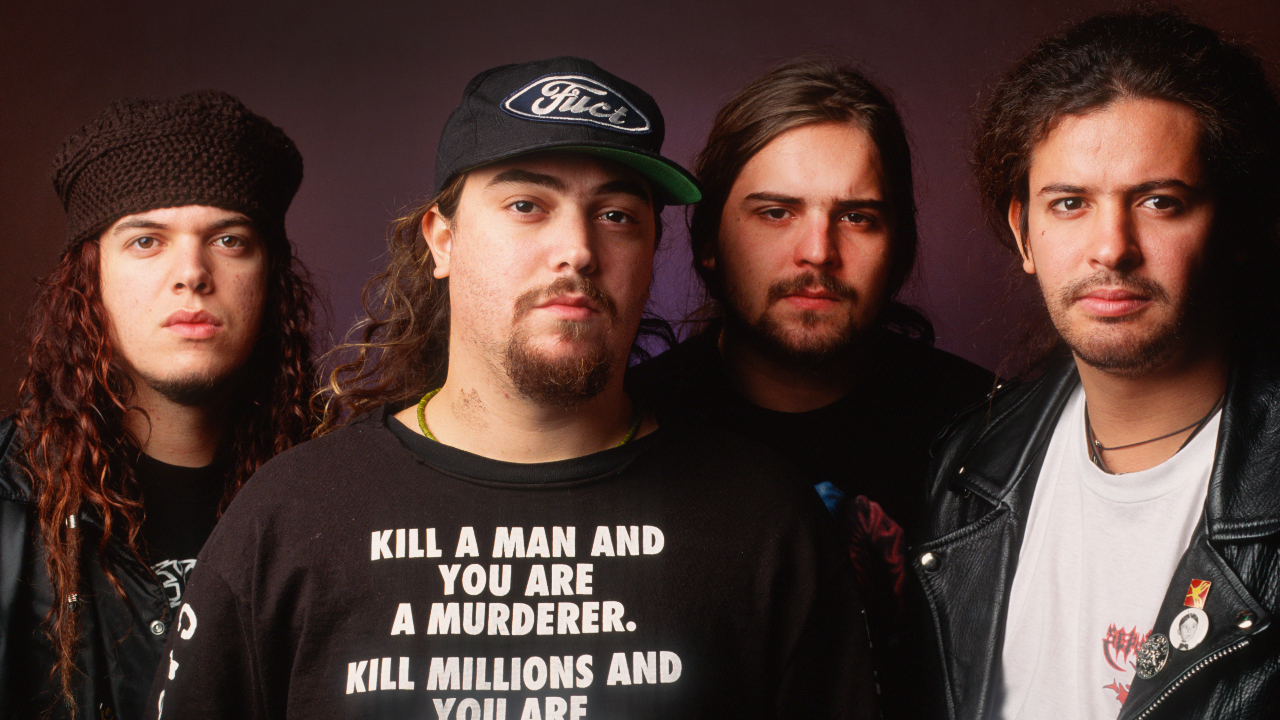“At the time, we had a lot of anger, a lot of depression, the world was crazy. That song reflected what we were thinking.” How Sepultura's Refuse/Resist captured the mood of a world in turmoil - and put South American metal on the map
Sepultura were already considered one of the most exciting bands in 90s metal. They just needed a song to take them to the next level

It was a glimpse of a leather jacket on a New York subway that sparked the song that would turbocharge Sepultura’s ascent from global ambassadors for Brazilian metal to one of the most important and influential bands of the 1990s.
“I was riding the subway in New York,” says former Sepultura frontman Max Cavalera. “There was a kind of Black Panther, punk kind of guy, and he had a black leather jacket with a protest verse painted on it. At the very end of the verse, it said: ‘Protest and survive/Refuse and resist.’ I got out of the subway and went back to our hotel and wrote it down so I didn’t forget it.”
That moment of inspiration became the driving engine of Refuse/Resist, the opening track and second single from 1993’s landmark Chaos A.D. album. This three-minute blast of noise and fury slowed down the bludgeoning barrage with which the band had made their name, helping propel these four feral 20-somethings from the sprawling city of Belo Horizonte firmly out of the underground metal ghetto and into the early 90s metal mainstream. Today, almost 30 years on, it still stands as one of the most recognisable calls-to-arms from that era or any other.
“At the time, we had a lot of anger, a lot of depression, the world was crazy,” says Max. “That song definitely reflected what we were thinking.”
Sepultura had served notice on their ambition a few years earlier. The primal death-thrash of 1989’s Beneath The Remains – their third full-length album, but their first via Roadrunner, at the time an influential underground metal label rather than the powerhouse it became – caused waves among those plugged into that scene. The follow-up, 1991’s Arise, came loaded with expectation, even if this exploding Molotov Cocktail of a record was still a little too ahead of the curve to be embraced by a world not yet quite primed for its relative extremity.
By 1993, the landscape was starting to shift. Death metal’s initial bludgeoning impact may have waned, but it had left a hammerprint on the mainstream metal scene, warping the boundaries of what was acceptable in terms of sonic brutality in the process. More pertinently, the success of Pantera’s game-changing Vulgar Display Of Power had recalibrated the dials, ushering in a bold new era for heavy music.
Sepultura themselves felt the change coming and were ready to meet it head on. “We were never satisfied with any of our albums,” says Max. “We were always, like, ‘OK, we’re done with this one, what can we do next?’ We were always looking for new stuff. We tried to reinvent ourselves as much as we could, which is a very hard thing to do sometimes.”
Sign up below to get the latest from Metal Hammer, plus exclusive special offers, direct to your inbox!
They were certainly aiming high with the album that would become Chaos A.D.. Max and co’s pool of influences had broadened way beyond thrash and death metal. Newer inspirations included everything from Ministry and rap-rock bruisers Biohazard to British post-punk firebrands New Model Army and even goth linchpins The Mission. “It was a transitional time for us,” says Max. “We started listening to different bands that we were thinking we could get influences from and put into our stuff.”
An even bigger marker of their ambitions came with the decision to enlist Andy Wallace as producer. Andy had worked with the likes of Slayer, Faith No More, White Zombie and Nirvana, as well as mixing Arise. He could heavy up alternative bands and make metal bands sound cutting edge.
“Andy actually came to [Sepultura’s adopted hometown] Phoenix and hung out in our jam-pad for about three days, making notes of all the songs,” says Max. “We never had anyone do that before: analyse the music, suggesting different things we could do.”
Max already had the germ of the idea for Refuse/Resist, thanks to the leather-jacketed punk on the New York subway. It dovetailed perfectly with a grinding, groove-heavy riff that had been rattling around his head. “It reminded me of a riot,” he says of the riff. “Cars burning and upside down, shit spread out all over the place, chaos everywhere. When I listen to it and close my eyes, I can see a riot even now. It’s definitely an anti-police song.”
That musical fury was reflected in a set of vivid lyrics that were partly inspired by some of the apocalyptic second-wave punk bands that Sepultura loved, such as Discharge and GBH. Max piled on images of tanks in streets, a population under siege from the authorities and mass disorder - part social commentary, part revolutionary rallying cry.
“We’d seen stuff happening all over the world, in Indonesia, in China, in Brazil, in America,” he says. “We were travelling more and more and we were learning about all this fucking bullshit that is politics.”
Ironically, Sepultura couldn’t have been further away from the front line when they recorded Chaos A.D.. The band and Andy Wallace decamped to Rockfield in South Wales, the rural studios where Black Sabbath, Led Zeppelin and Queen had recorded some of their most famous albums.
“We were hanging around the pubs in Monmouth and Chepstow, the same places where Geezer Butler and Robert Plant would have had a pint,” says Max with a laugh. “We were definitely looking for that vibe. We were living beyond our dreams.”
Yet they still brought a little bit of Brazil with them to the valleys. Iggor Cavalera’s opening drum salvo – played on a smaller, piccolo drum snare – foreshadowed the indigenous rhythms Sepultura would explore in more depth on follow-up album Roots.
“It was Andy who wanted to bring together Brazilian music and metal in a culture clash,” says Max. “I wasn’t sure they’d go together, I thought they were too far apart. But he said, ‘No, you should go there.’ He was right.”
Refuse/Resist closed with Max’s epic, 20-second roar of fury, but the song’s opening was equally striking. It begins with an unearthly pulse – actually the sound of the heartbeat of Max and wife Gloria’s unborn son, Zyon, captured during an ultrasound scan.
“I love that intro,” says Max. “That was fun - I was right there in the clinic with a MiniDisc and headphones, trying to record the heartbeat sound with the nurses. It was important to get that right because it’s such a unique intro.”
In 2010, Max brought things full circle when his post-Sepultura band, Soulfly, recorded a cover of Refuse/Resist featuring a 17-year-old Zyon Cavalera on drums for a bonus track on the Omen album. “It was Zyon’s choice to cover that song,” says Max. “It was the perfect thing to do.”
Sepultura’s original version of Refuse/Resist was released in February 1994 as the second single from Chaos A.D.. In keeping with the track’s lyrical theme, the single featured an image of a protester leaping at a line of police riot shields while fire burns in the street. The video went even further, incorporating footage of the unknown man who faced down a line of Chinese tanks during 1989’s infamous Tiananmen Square uprising – one of the most famous images of protest in history.
Sepultura would have their own run-in with the authorities, albeit inadvertently. In 1994, the band appeared at a festival in São Paulo in Brazil. At the end of the set, as Max hoisted his 18-month-old son Zyon above his head, someone threw a Brazilian flag onstage. As they left the stage, Max was bundled into the back of a van and driven to a nearby police station, where he was informed that he had been arrested for urinating on the national flag (he hadn’t and was eventually released without charge, though his alleged actions prompted a national outcry).
Chaos A.D. had already kicked Sepultura to the next level, giving them their first US Top 40 album and reaching No.11 in the UK charts when it was released in September 1993. Refuse/Resist, with its roar of defiance, consolidated their status as one of the most vital metal bands of the decade, even if things were subtly beginning to change within the band.
“When we lived in Belo Horizonte, we were a full-on gang,” says Max. “We were together 24 hours a day. We even went to jail together. By the time of Chaos A.D., it was not so much like a gang, it was more like a regular band. People were having relationships and other things. It was different.”
Sepultura would make one more album with Max, 1995’s Roots, before the singer left acrimoniously the following year. Today, Refuse/Resist remains the band’s most enduring riot-starting anthem, and one of their most successful.
“I’ve never really paid much attention to that stuff,” says Max. “The word ‘success’ doesn’t mean much to me. It’s like the Grammys – they’re like haemorrhoids, ’cos eventually every asshole gets one. I never got into music for that. We were in it for the metal and what it represented. Music for me was my weapon, and in Sepultura it was my weapon big time.”
Dave Everley has been writing about and occasionally humming along to music since the early 90s. During that time, he has been Deputy Editor on Kerrang! and Classic Rock, Associate Editor on Q magazine and staff writer/tea boy on Raw, not necessarily in that order. He has written for Metal Hammer, Louder, Prog, the Observer, Select, Mojo, the Evening Standard and the totally legendary Ultrakill. He is still waiting for Billy Gibbons to send him a bottle of hot sauce he was promised several years ago.

